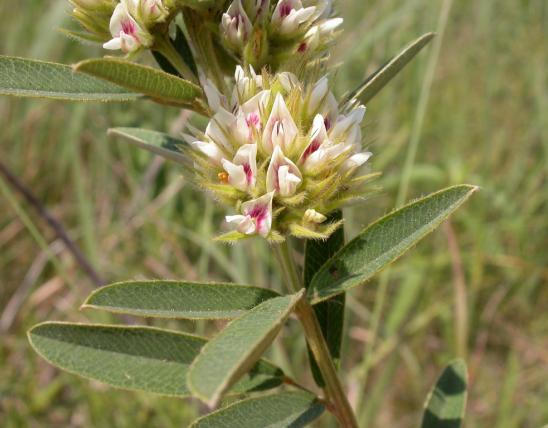
Sericea lespedeza is a warm-season, perennial legume with erect, herbaceous to somewhat woody stems, with many erect, leafy branches.
Flowers are ¼ to ⅜ inch long and in clusters of mostly 2–3 in upper leaf axils. The petals are cream colored with purple or pink markings. Blooms July–October.
Leaves are green to ashy green, with densely flattened hairs, compound with 3 leaflets, the leaflets ¼ to 1 inch long. The lower leaves have leaf stalks, but the upper leaves have little or no stalks. The leaflets are much longer than wide, tapering to the base, and wider above the middle, narrowing abruptly to a small sharp point.
Its myriads of seeds are borne in small oval pods that are up to ⅛ inch wide.
Similar species: About 11 species of Lespedeza (bush clover) have been recorded from Missouri, and sericea lespedeza is one of three that are nonnative. Perhaps the most similar, widespread bush clover is native slender lespedeza (Lespedeza virginica); it does not have the distinct “fishbone-like” venation pattern that sericea lespedeza has. Also, the native has light to dark pink flowers (not cream-colored petals with purplish markings).
Height: 3 to 6 feet.

Statewide.
Habitat and Conservation
Native to Asia; widely introduced; now found in every county in Missouri. It tolerates both droughts and floods. While it prefers full sun, it can survive in partial shade, allowing it to invade a wide range of habitats and climates. It is commonly found in open woodlands, thickets, fields, prairies, disturbed open ground, gravel bars, borders of ponds and swamps, meadows, and especially along roadsides.
Status
Invasive forb. Sericea grows in places where other plants cannot. It is fixes nitrogen, so it can survive in poor soils.
Although introduced in hopes of providing food for wildlife, sericea lespedeza is unpalatable compared to native species because of the high concentration of tannins in its tissues. Sericea has a deep taproot allowing it to outcompete native plants for water and nutrients. Also, it drops 1,000 or more seeds from each stem, and these can remain viable for over two decades.
Life Cycle
Stems arise in the spring (middle to late April) from root crown buds at the bases of the previous year’s stems. Flowering begins in late July and can continue through October. As flowering progresses, root reserves are increased, a fact that influences the effectiveness of certain herbicides. Seeds are dispersed in the fall and can remain viable for more than 20 years. Birds may play a role in seed dispersal, and certainly the species is spread by haying of infested fields.
Control
Human Connections
Decades ago, this exotic species was introduced widely in the United States to provide hay, improve pastures, stop soil erosion, and supply food and cover for wildlife. Unfortunately, it has proven to be an aggressive, invasive weed that is extremely difficult to control, escapes cultivation, and outcompetes native plants.
To control sericea lespedeza, early detection is key: you can pull or spray it. If it's established, an integrated approach is best, mowing, burning, and/or spraying, most likely over several seasons.
There are many great native perennial forbs that can be planted as an alternative to sericea lespedeza. We recommend slender lespedeza, blue or yellow wild indigo, partridge pea, Virginia wild rye, little bluestem, and wild senna.
This species used to have the scientific name of Lespedeza sericea; the former species name, sericea, came from a Greek root meaning "silky" or "silken," referring to the silky-looking, hairy leaves. Combined with the genus, the name means "silky Lespedeza" or "silky bush clover." Even after botanists changed the scientific name to Lespedeza cuneata, the word sericea stuck and remained as a common-name adjective. Cuneata means "wedge-shaped," "pointed," or "tapering." It refers to the narrowly triangular leaflets, which are widest at the outer tip and taper toward the base.
Ecosystem Connections
Tannins and tough stems in this plant make it unpalatable to grazers, which in turn overgraze the surrounding native plants. This reduces biodiversity and helps sericea outcompete other plants. Also, chemicals produced by the drought-tolerant sericea stunt the growth of surrounding plants.

























